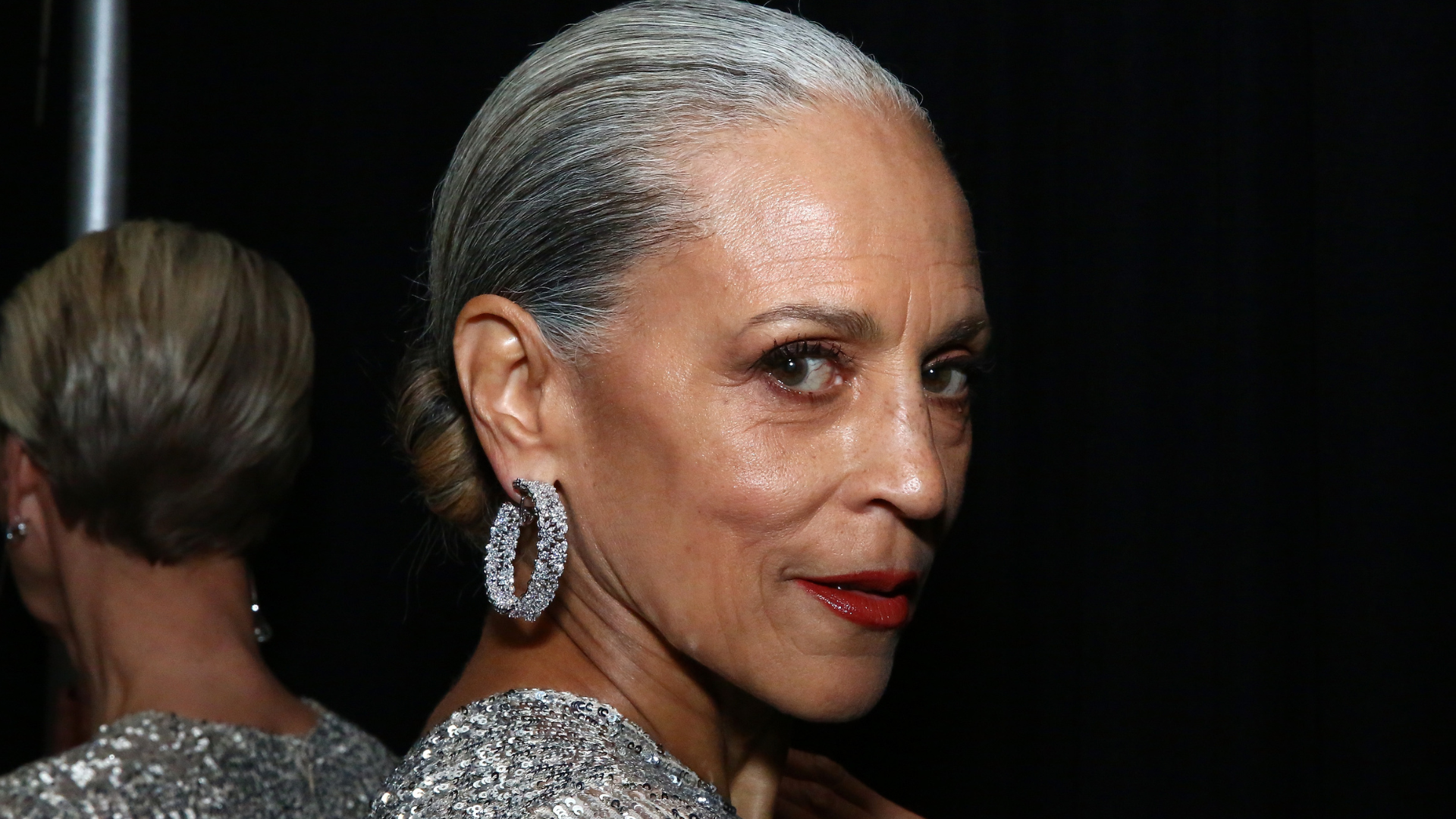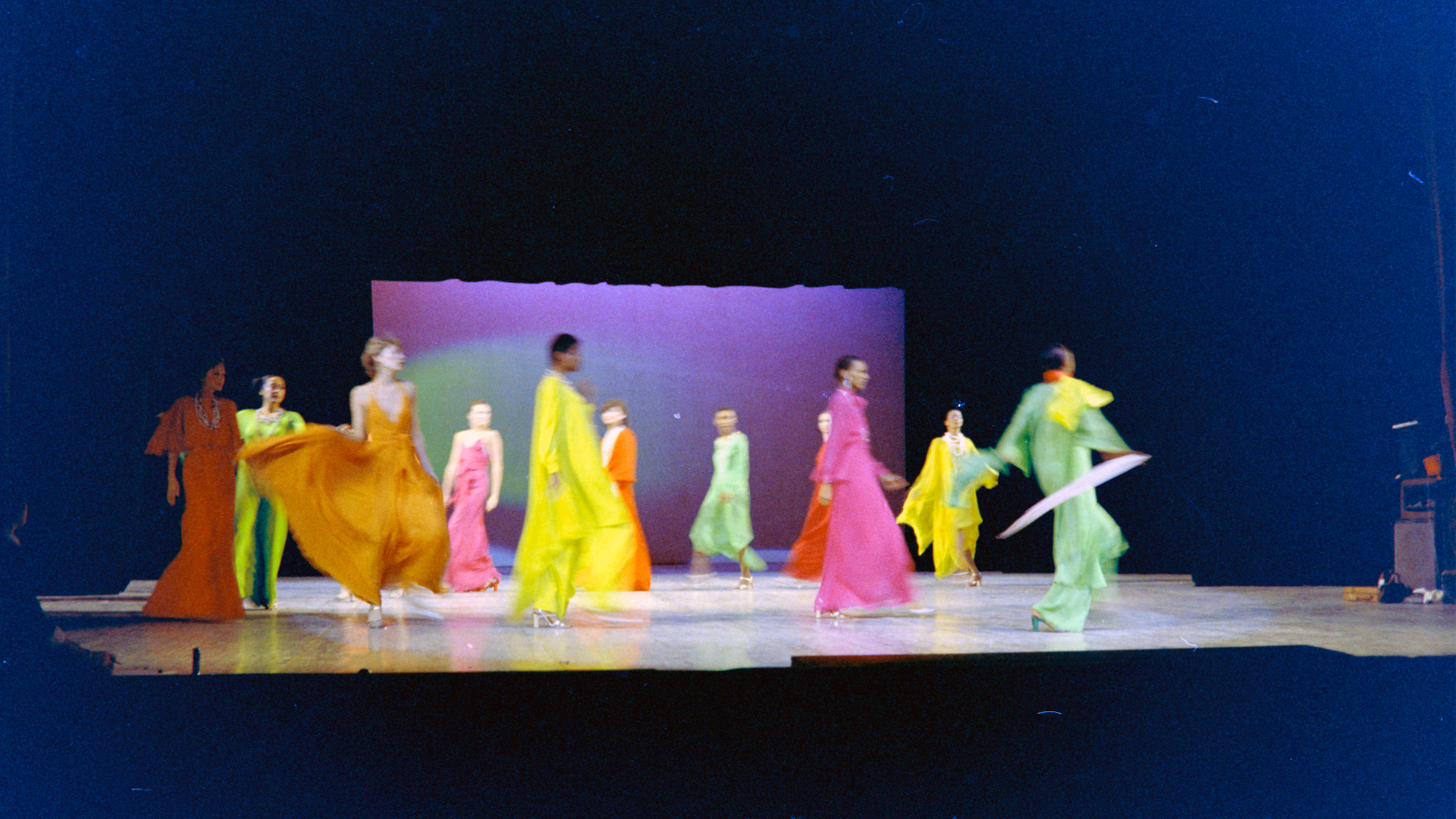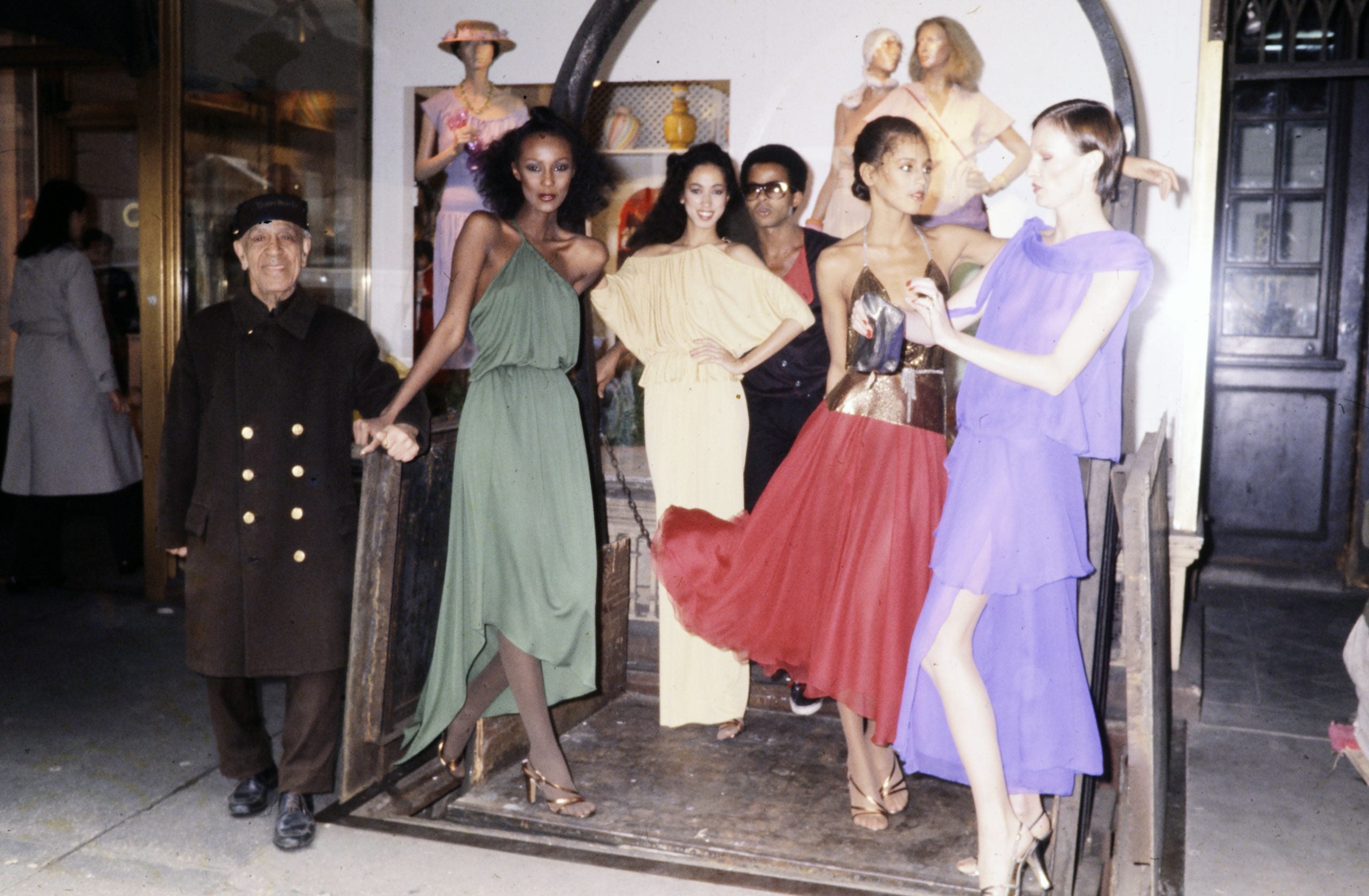 Getty Images
Getty Images It was a decade after Kwame Braithwaite rendered portraits of Black beauty, that a night in Paris secured not only American fashion’s dominance but a glistering era for the Black supermodel. The Palace of Versailles, a former residence of Louis XIV was in need of “restoration” and to fundraise, publicist Eleanor Lambert created a runway show which was coined as an introduction of American designers to the global fashion industry. A benefit idea was sparked after Lambert was introduced to Versailles curator, Gerald Van der Kemp. Then, French couturiers signed on to be a part: Hubert de Givenchy, Yves Saint Laurent, Pierre Cardin, Emanuel Ungaro, and Marc Bohan of Christian Dior. The American camp consisted of sportswear and ready-to-wear designers: Oscar de la Renta, Halston, Bill Blass, Anne Klein, and Stephen Burrows. With these additions, eventually due to the savviness of media titan John B. Fairchild, the Battle of Versailles became the title for the 1973 extravaganza.
The night of the show, Josephine Baker took center stage, followed by the French’s two-and-a-half-hour segment. Their segment boasting absurd extravagance featured a full orchestra, live rhinoceros, a pumpkin-shaped carriage, and a Bugatti cruising down the runway. Newly minted Oscar awardee, Liza Minnelli served as entertainment for the American troupe. But it was a kaleidoscopic group of models with vigor, personality, and rhythm that won over a crowd of luminaries that night, and equally intriguing was that ten of them were Black.
 The Battles of Versailles (Photo: Getty Images)
The Battles of Versailles (Photo: Getty Images)
At face value, a fashion battle as a means to repair Versailles appears removed from the world’s plight. Yet, the Americans captured the ethos of the times, mirroring a world where ready-to-wear was popularized, Black designers could scale, and Black women were indisputable images of glamor. While the seminal occasion is more fascinating than politically radical, it revolutionized the industry recognizing fashion as international, rather than solely French. Consequently, Black women had walked in French shows before. In fact, by the late ’70s, an impassioned Givenchy had five Black models as his house models, these women were also a part of his inner circle, according to WWD.
The American troupe was ethnically diverse with flamboyance to spare–their appearance in the lauded Grand Divertissement à Versailles launched the careers of legendary Black models Pat Cleveland, Billie Blair, Bethann Hardison, and Alva Chinn. As a figure who swiftly rose to prominence following The Battle of Versailles, Chinn personifies the top model of the ‘70s. Muses at the time were collaborative sources of inspiration and in an era where models were just as famous as the designers they walked for, she functioned as one of the faces of Halston. Following her life-changing moment in Versailles, she also went from a fashion neophyte to walking in presentations for Gianni Versace, Yves Saint Laurent, Oscar de la Renta, and more. She also worked with Stephen Burrows and Marc Bohan. Over the years she’s expanded her creative capacity, in 2020 Chinn made her foray into acting with her most recent appearance in a Sofia Coppola film, “On The Rocks.”
“I would say that ready-to-wear coming to the fore was part of the fact that this energy was not just us as Black models, it was the energy of the music, which was R&B,” Chinn says when speaking on the Battle of Versailles and what stood out to her. She adds, “It was all the present-day energy of the time in your face.”
Her memories point out a level of excitement that in recent years just may be returning to fashion due to designers such as Christopher John Rogers. But beyond the energy that was injected into the industry following the Battle of Versailles, Chinn’s career and the careers of her peers like Cleveland and Hardison have forever shifted the cosmos of the pop culture lexicon. Without these formative women, many of the iconic Black models we acknowledge today would cease to exist.
In celebration of The Battle of Versailles’ 50th Anniversary, ESSENCE.com spoke with the famed Halstonette and pioneering model Alva Chinn. Below we discuss what it was like walking for the beloved Versailles designers, her memories of Gianni Versace, and her personal evolution.
ESSENCE.com: You were discovered after a waitress handed you a card at a restaurant right after a bad breakup. What’s the difference between Alva then and Alva now?
Alva Chinn: We had not actually even broken up, he had just journeyed off, and that was actually one of my first loves, but he made me realize something, never wait for a man. I was extremely shy, certainly not fully myself. I was quite observant of other human beings, but I really didn’t know what would make my heart sing, and that’s our primary job.
How did the opportunity to model in Versailles come about?
I had worked for three of the people that were there. Oscar [De La Renta], Stephen [Burrows], and Halston that past season and that was my first New York fashion show season. When energy clusters it moves you forward even if it’s from one situation to move you to the next one. This just happened to be that they were all together and it was on my favorite day of the year, which is still my favorite day of the year, Thanksgiving. You can’t ask for anything better than that.
It was a pretty extensive process for the Battle of Versailles, what was the day of the show like?
I really thought I had worked for all five, but I hadn’t worked for Bill Blass. Honestly, it was the biggest, fastest changing I have ever done. Back in the day, you would have more than one change, for sure. And usually, you had up to maybe eight. So you had to know how to change your clothes quickly. But, there I was undressed, [I was] moving to the next person, undressed, on stage, back undressed moving to the next person. So I was naked most of the time.
It was reported that there was very little time to rehearse.
Oh, that’s because the French took up all the time. That’s it they just took up all the time. [laughs] And if they take up all the time you really can’t rehearse. Luckily, Oscar [De La Renta] took Billie Blair and some other models out to work on his segment, which was the final segment. I think because he was such a lover of his homeland the [Dominican Republic] that the rhythm of the snake [where] Billie Blair [is] like a magician moving we ladies through the spake like a magician and a serpent to me was him honoring his roots.
So due to the lack of time to rehearse, where did your inspiration stem from?
No, there [actually] wasn’t [time to rehearse]. It was mostly sitting in the cold and wishing you were fed and at least had some water. I learned to appreciate something that I didn’t appreciate then and I wouldn’t understand it until years later. My crying because I was not feeling honored by the French, it really hurt my feelings. I loved what Josephine Baker said [to me] because I admired her, [and] I never had the chutzpah that she had [but] I admired her bravery and belief in herself.
She said to me, “What’s a pretty girl like you doing crying? It’s wonderful that you’re here.” And so, that made me understand that each moment that you appreciate what comes to you energetically it’s to support you in moving yourself forward.
 Designer Stephen Burrows with models. Models Iman, Pat Cleveland, Alva Chinn. (Photo by Lynn Karlin/Penske Media via Getty Images)
Designer Stephen Burrows with models. Models Iman, Pat Cleveland, Alva Chinn. (Photo by Lynn Karlin/Penske Media via Getty Images)
So, before Versailles, was it rare for Black women to be in couture shows in Europe?
There were always some Black women who worked in couture in France. However, there were never as many of us as there were in this ready-to-wear show. We were all different sizes, all different hues. I was a geeky, nerdy, awkward-looking alien. So I worked really well for Stephen’s segment–because I was so skinny, and I had great shoulders. I’ve always had great shoulders, so I’m a good hanger. And I know how to move.
For Black models what were some other advantages of modeling at the Battle of Versailles?
The fact that ready-to-wear had made it possible. Yves [Saint Laurent] already had ready-to-wear and Pierre Cardin already had that [as well]. So I would say that ready-to-wear coming to the fore was part of the fact that this energy was not just us as Black models, it was the energy of the music, which was R&B. It was all the present-day energy of the time in your face, and making them realize that music had rhythm that made women move in a different way. There were a fair amount of dancers there too from the beginning and the end—dancers understand music no matter what color they are so it’s about movement, and we [American models] brought another movement to fashion.
What was it like after your Versailles modeling moment?
[It was] an opportunity that brought other opportunities that moved to the next, to the next to the next. And I did not take myself out of the running by not going to Europe without any guarantee. I went to Italy first but then I went to Paris with a sense that I belonged. Actually, I felt like I belonged before I ever went to Europe. When I was younger, I studied Latin and French.
What was it like working with Gianni Versace?
Working with Versace was for me perfect pairing and timing. He was generous of heart and soul besides making beautiful clothes that were not only colorful and sensual, they had an ease that made me feel at home. Actually, he welcomed me to go to Milan exclusively for him, which was perfect since I’d had a baby and did not want to do the circuit [of] Milan [to] London [and then]Paris) and [lastly] coming to New York to do shows. Besides, he always had interesting guests at his celebration dinner. And that smile of his was a welcome in itself. I love and miss his presence.
What moment are you most proud of from that historic day in Versailles?
I do not have a proudest moment for there are so many that touch my soul and fill me with gratitude. Being a part of a time when creativity, mutual understanding, and respect for the work was and is an energy filled with love, so my inner child gets to come out to play!
Do you feel like you’ve found what would make your heart sing?
I think I found some of what makes my heart sing. I would say some of what I have achieved has given me joy and pleasure, especially since I honored those who respected me and my interest in what they created. So that in itself is a true gift, choosing something that works for everyone. If we had less of the world of selfie-dom and more about all of us we would be in a better place.
TOPICS: bethann hardison Black Models black supermodel versailles 73The post A Conversation With Alva Chinn On The 50th Anniversary of The Battle of Versailles appeared first on Essence.


0 Commentaires